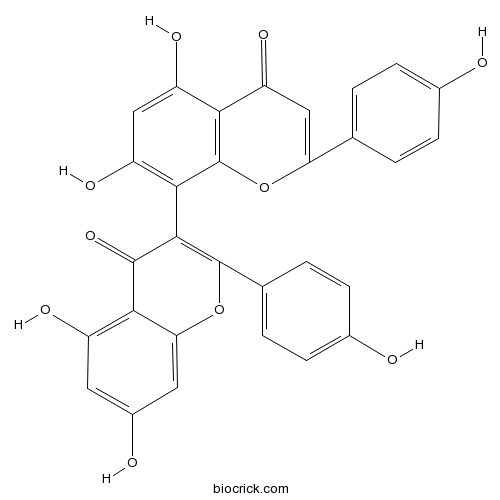3,8'-BiapigeninCAS# 101140-06-1 |

Quality Control & MSDS
3D structure
Package In Stock
Number of papers citing our products

| Cas No. | 101140-06-1 | SDF | Download SDF |
| PubChem ID | 10414856 | Appearance | Yellow powder |
| Formula | C30H18O10 | M.Wt | 538.5 |
| Type of Compound | Flavonoids | Storage | Desiccate at -20°C |
| Synonyms | 3,8''-Biapigenin | ||
| Solubility | Soluble in acetone and chloroform | ||
| Chemical Name | 3-[5,7-dihydroxy-2-(4-hydroxyphenyl)-4-oxochromen-8-yl]-5,7-dihydroxy-2-(4-hydroxyphenyl)chromen-4-one | ||
| SMILES | C1=CC(=CC=C1C2=CC(=O)C3=C(O2)C(=C(C=C3O)O)C4=C(OC5=CC(=CC(=C5C4=O)O)O)C6=CC=C(C=C6)O)O | ||
| Standard InChIKey | IQAMTZLKUHMPPE-UHFFFAOYSA-N | ||
| General tips | For obtaining a higher solubility , please warm the tube at 37 ℃ and shake it in the ultrasonic bath for a while.Stock solution can be stored below -20℃ for several months. We recommend that you prepare and use the solution on the same day. However, if the test schedule requires, the stock solutions can be prepared in advance, and the stock solution must be sealed and stored below -20℃. In general, the stock solution can be kept for several months. Before use, we recommend that you leave the vial at room temperature for at least an hour before opening it. |
||
| About Packaging | 1. The packaging of the product may be reversed during transportation, cause the high purity compounds to adhere to the neck or cap of the vial.Take the vail out of its packaging and shake gently until the compounds fall to the bottom of the vial. 2. For liquid products, please centrifuge at 500xg to gather the liquid to the bottom of the vial. 3. Try to avoid loss or contamination during the experiment. |
||
| Shipping Condition | Packaging according to customer requirements(5mg, 10mg, 20mg and more). Ship via FedEx, DHL, UPS, EMS or other couriers with RT, or blue ice upon request. | ||
| Description | 3, 8''-Biapigenin can modulate intracellular ROS production. |
| Targets | ROS |
| In vitro | Cellular reactive oxygen species inhibitory constituents of Hypericum thasium Griseb.[Pubmed: 19203769 ]Phytochemistry. 2009 Jan;70(2):244-9.
|

3,8'-Biapigenin Dilution Calculator

3,8'-Biapigenin Molarity Calculator
| 1 mg | 5 mg | 10 mg | 20 mg | 25 mg | |
| 1 mM | 1.857 mL | 9.2851 mL | 18.5701 mL | 37.1402 mL | 46.4253 mL |
| 5 mM | 0.3714 mL | 1.857 mL | 3.714 mL | 7.428 mL | 9.2851 mL |
| 10 mM | 0.1857 mL | 0.9285 mL | 1.857 mL | 3.714 mL | 4.6425 mL |
| 50 mM | 0.0371 mL | 0.1857 mL | 0.3714 mL | 0.7428 mL | 0.9285 mL |
| 100 mM | 0.0186 mL | 0.0929 mL | 0.1857 mL | 0.3714 mL | 0.4643 mL |
| * Note: If you are in the process of experiment, it's necessary to make the dilution ratios of the samples. The dilution data above is only for reference. Normally, it's can get a better solubility within lower of Concentrations. | |||||

Calcutta University

University of Minnesota

University of Maryland School of Medicine

University of Illinois at Chicago

The Ohio State University

University of Zurich

Harvard University

Colorado State University

Auburn University

Yale University

Worcester Polytechnic Institute

Washington State University

Stanford University

University of Leipzig

Universidade da Beira Interior

The Institute of Cancer Research

Heidelberg University

University of Amsterdam

University of Auckland

TsingHua University

The University of Michigan

Miami University

DRURY University

Jilin University

Fudan University

Wuhan University

Sun Yat-sen University

Universite de Paris

Deemed University

Auckland University

The University of Tokyo

Korea University
- Tenovin-3
Catalog No.:BCC3889
CAS No.:1011301-27-1
- Larixinol
Catalog No.:BCN6484
CAS No.:101046-79-1
- Microcystin-LR
Catalog No.:BCC5339
CAS No.:101043-37-2
- MK-5108 (VX-689)
Catalog No.:BCC2176
CAS No.:1010085-13-8
- Bis[4-(dimethylamino)phenyl]methane
Catalog No.:BCC8889
CAS No.:101-61-1
- Hyoscyamine
Catalog No.:BCN1946
CAS No.:101-31-5
- Pyridostigmine Bromide
Catalog No.:BCC4579
CAS No.:101-26-8
- CY 208-243
Catalog No.:BCC6991
CAS No.:100999-26-6
- Levofloxacin
Catalog No.:BCC4791
CAS No.:100986-85-4
- CX-4945 (Silmitasertib)
Catalog No.:BCC3693
CAS No.:1009820-21-6
- NSC 687852 (b-AP15)
Catalog No.:BCC2389
CAS No.:1009817-63-3
- Thiamet G
Catalog No.:BCC4864
CAS No.:1009816-48-1
- Milnacipran HCl
Catalog No.:BCC4922
CAS No.:101152-94-7
- Odoriflavene
Catalog No.:BCN8240
CAS No.:101153-41-7
- Tenovin-6
Catalog No.:BCC3667
CAS No.:1011557-82-6
- Momordicoside P
Catalog No.:BCN3275
CAS No.:1011726-62-7
- Longipedlactone J
Catalog No.:BCN6644
CAS No.:1011762-93-8
- CUDC-101
Catalog No.:BCC2149
CAS No.:1012054-59-9
- IRAK inhibitor 4
Catalog No.:BCC1657
CAS No.:1012104-68-5
- Picrasidine Q
Catalog No.:BCN3182
CAS No.:101219-61-8
- IRAK inhibitor 3
Catalog No.:BCC1656
CAS No.:1012343-93-9
- Kushenol K
Catalog No.:BCN3448
CAS No.:101236-49-1
- Kushenol L
Catalog No.:BCN3309
CAS No.:101236-50-4
- Kushenol M
Catalog No.:BCN3310
CAS No.:101236-51-5
Cellular reactive oxygen species inhibitory constituents of Hypericum thasium Griseb.[Pubmed:19203769]
Phytochemistry. 2009 Jan;70(2):244-9.
The phytochemical investigation of the ethyl acetate extract of Hypericum thasium has led to the characterization of four benzophenone derivatives 1-4, a known benzophenone 5 and four known flavonoids, quercetin (6), quercitrin (7), isoquercetin (8), and 3, 8''-biapigenin (9). Lucigenin- and luminal-based chemiluminescence assays were employed to monitor the inhibitory activity of these compounds towards the production of reactive oxygen species (ROS) by human polymorphoneutrophils (PMNs). The assay results showed that benzophenones 1 and 3 are extracellular inhibitors of ROS production, while flavonoids 6, 8, and 9 can modulate intracellular ROS production.


